There were three Wrights who were originally from England and worked in custom gun making in America.
There was John R. Wright Sr and Jr as well as Samuel G. Wright.
I will go into much more detail tomorrow, and we can discuss and debate what it all means.
A few pictures to give you an idea.
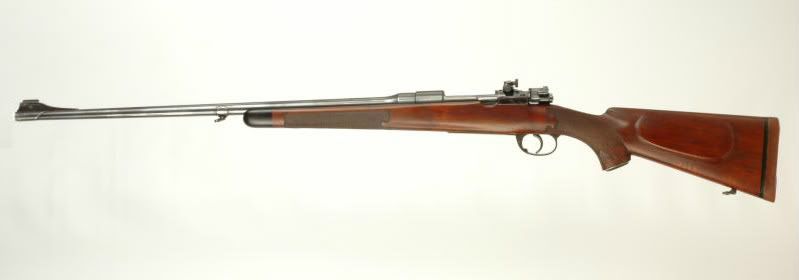

Michael,
How old do you think that rifle is? I ask because I notice that they have abbreviated Missouri as MO. That is the state's postal abbreviation that I think the USPS adopted in the 60s or 70s. Maybe in the case of Missouri it was always MO, but it surprises me. I would not expect a pre-war rifle from Minnesota to have MN in dual capitals and no period, but rather Minn.
Nice checkering. What caliber is it?
Brent
Remember "The Mighty Mo?" They have called Missouri "Mo" for short for many years.
Good point. So, just a coincidence that Missouri already had a 2-letter abbreviation before USPS mandated it for all states.
A little more about this rifle specifically, I've had it for a couple years but it's been in the rifle hospital. Someone had mounted a modern scope by drilling and tapping the receiver, badly grinding and bending the bolt, cut a big groove in the side of the stock and the action. Normal butcher job commonly found on many prewar sporters.
It would've been made around 1929 and I think it's a 30-06, I'll have to check that.
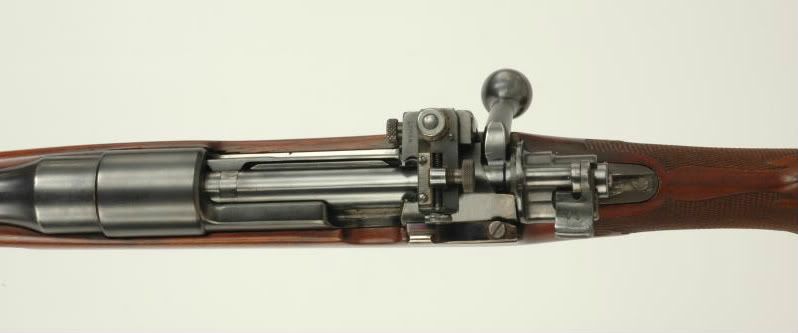
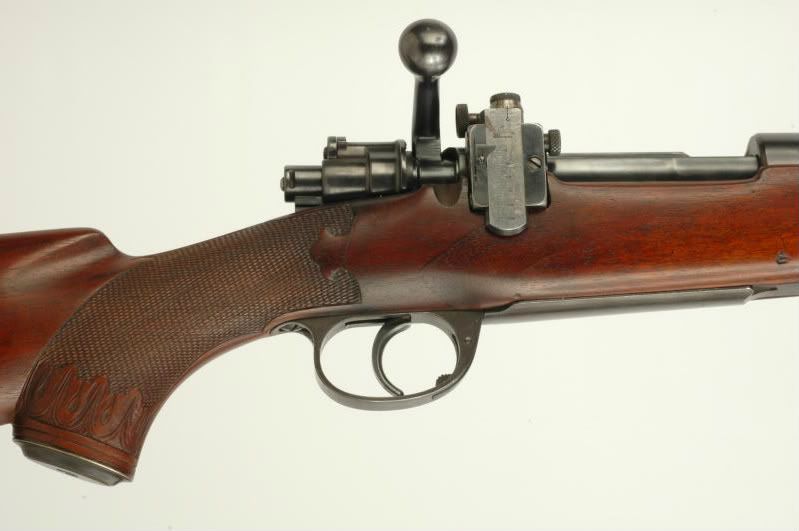
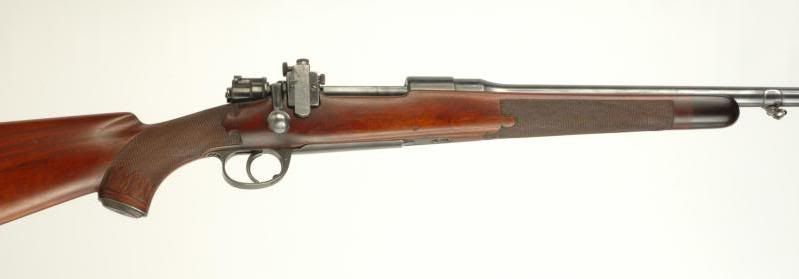
I'm going to go into some detail on the Wrights. I've been working on them for some time but still have a long ways to go before I can say positively say "this is fact". Right now this is just my opinion and as I have more time to devote to them I'm sure more things will change.
John R. Wright Jr. was born in 1896 came over on the S.S. President Polk, arriving in New York on Sept. 26, 1923 and went to work for Griffin and Howe. I believe his occupation on the paperwork I have is listed as engineer. I believe that many of the very early Griffin & Howes were stocked by him.
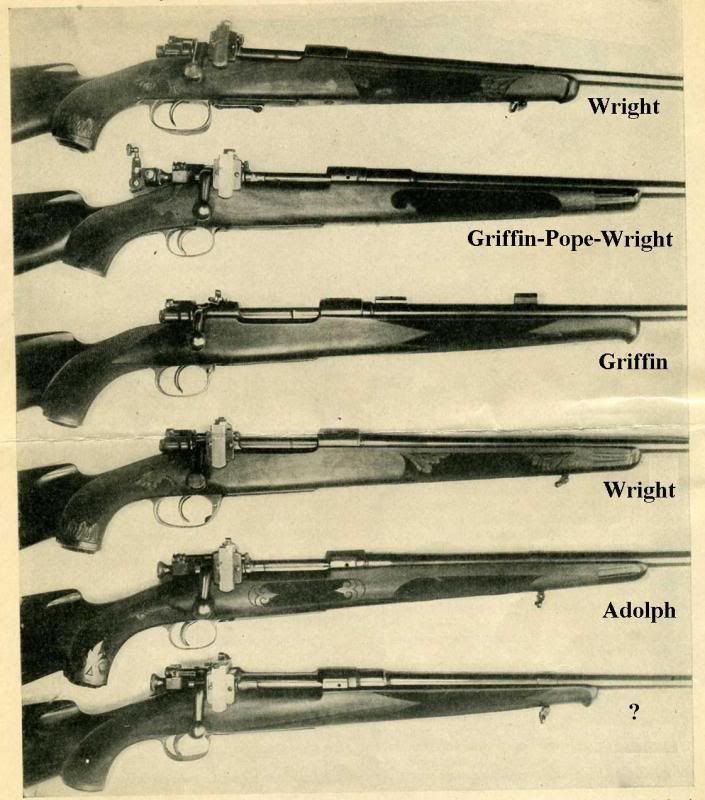
The attending physician did a wonderful job!
The rifles that show what I believe to to be John Wright's work only show up on very early Griffin and Howes.
I believe that he may have left G&H with James V. Howe to join the Hoffman Arms Company in Cleveland Ohio.
A little better picture of the barrel markings.

When Hoffman Arms Company move to Ardmore Oklahoma John Wright Jr. moved with them.
John R. Wright Sr. was born in 1873 and arrived in 1925 and went to work for Hoffman Arms Co. Ardmore Oklahoma.
Samuel G Wright was born in 1900 and arrived in American in 1926 and went to work for Hoffman Arms Co. Ardmore, Oklahoma.
As Hoffman began to fall apart and everyone started splitting up.
I Found an ad(s)1928-June-July….. Hoffman & Wright PO Box 87 Ardmore, Oklahoma. I have no idea if this was Sr. or Jr.
1928-October….. John Wright (no sons) 1844 East 40th Street Cleveland, Ohio. This was most likely John Jr. As he worked in Cleveland and no sons listed in the name. I have never seen reference to our know of a Wright rifle marked Cleveland.
This would have been John Sr.
1929- March- April…… Baker & Wright Arms & Equipment Co. 550 Gibraltar Bldg Kansas City, Missouri. The Baker was Clyde Baker who wrote "Modern Gunsmithing".
1929- March- April- August-September…. John Wright & Sons, 550 Gibraltar Bldg, 818 Wyandotte St. Kansas City, Missouri.
To better understand the address it was room 550 of the Gibraltar Building located at 818 Wyandotte Street.
When John Wright Senior was advertising as John Wright and sons both John Junior and Samuel were both living in Cleveland and working as assemblers for auto.
Over the years I have tried to locate a rifle from each of the employees of Hoffman Arms Co. who went out on their own and made rifles under their name.
I have one picture of the Hoffman rifle made by Frank Hoffman before the company started in Cleveland. That's it I've never seen a single other rifle that I knew was made by Frank Hoffman.
I have located rifles by
John Dubiel
Eric Johnson (Ardmore, OK)
James V.Howe
Harvey Rodgers
John Wright & Sons
I know of another possible rifle that may have been made by a Hoffman employ but have not confirmed that.
Mike, interesting stuff. Your picture with the Wright, Adolph, and Griffin-Pope-Wright rifles shows rifles by which Wright ? I am struck by what I would call the non-English look of the carving and checkering. Would you think it a common motif from an English background? You mention John Wright Jr. probably stocking at G and H in the earlier 20s. That would put him there at the time Adolph is suspected of being there. Could there be some Adolph or other German part to those Wright rifles ? I say this without knowing the Hoffman influence on the Oklahoma guns.
Daryl,
You bring up some very good points, many that I have mulled over for years. Every source I have shows that Wright did the carving at Hoffman. Nothing I would expect from an English trained gunsmith.
There has always been some lingering doubt right up until the time I acquired the Wright rifle. I guess one of the big question is who carved the Wright & Sons rifle. Did senior teach junior to carve or did he send the stock to Cleveland to have Junior do it.
This is Cleveland Hoffman No. 20, Cleveland Hoffman No. 24 is stocked by J.V. Howe.
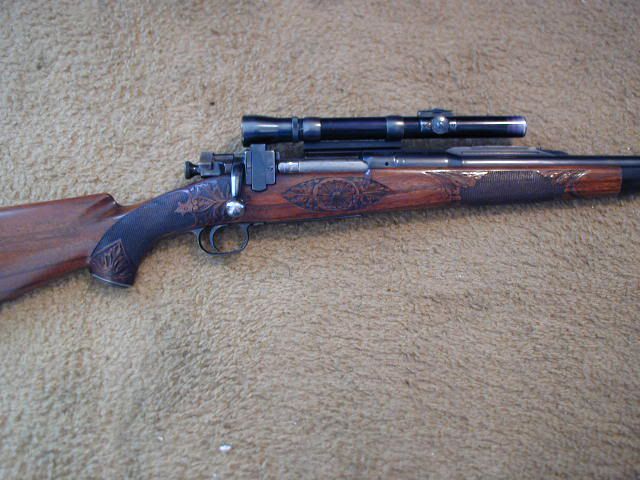
"Your picture with the Wright, Adolph, and Griffin-Pope-Wright rifles shows rifles by which Wright ?"
Would have to been Jr, Sr did not arrive in the USA until 1925 and went to Ardmore. The picture is from circa 1923 Griffin and Howe brochure.
Mike, I have found in my files the same rifles in a G and H brochure you listed with the names or Wright, Adolph, and Griffin-Pope-Wright. I know virtually nothing about these rifles compared to the frequent posters on this board, but how were the names assigned to the group of rifles, with the lower one left unknown ? My brochure [assumed 1923-1924] has no names with the rifles in the brochure.
The Wright rifles shown in the G and H brochure would have to be John Wright Jr. The checkering and carving on these rifles would be by whom ?
If John Wright Jr. did the checkering and carving, it seems a good question as to who taught him. If these rifles were checkered and carved by Wright Jr. , then it seems he could have done the same when he moved on to Hoffman in Ardmore. Is that what you meant when you said that "Wright" did the checkering and carving in Ardmore. Or did you mean Wright Sr. did the Ardmore checkering and carving ?
Well, there are more questions, but those can wait. Thank you.
Sorry for the confusion, The names in the brochure are mine.
More questions than answers could be the name of this thread. I'm trying to sort it all out and think I need to sign up for getting into the records in England.
Here is some stuff from my files, I believe that Pete supplied the England part.
John R. Wright is listed in the 1901 England census as residing with his wife, Ada, in Willesden, Middlesex. His sons names were John R. (5 y.o.) and Samuel G. (2 y.o.) and Mr. Wrigtht's occupation is listed as "Gunmaker". Mr. Wright, Ada and the eldest son were all born in Birmingham. Samuel was born in Willesden, Middlesex.
Ada and Samuel G. Wright (mother and son) arrived in the USA from Southampton, UK aboard the S.S. President Roosevelt on February 6, 1926. Ada'a age was 53 and Samuel was 26. Samuel's occupation was listed as Gunsmith. Their last permanent residence was London but they listed their nearest living relative as Ada's sister, Mrs. F.H. Mason at 305 Witten Rd in Ashton, Birmingham. Their final destination was to be Ardmore, OK where, I would assume, they were to meet Ada's husband, John. According to the 1930 US census John (senior) arrived in the USA the year before Ada but I've not yet found him on the passenger manifests.
Still more. Samuel G Wright, Gunsmith, his wife, Lily G., and their 3 children traveled (returned?) to England aboard the Steamship 'Majestic' in August 1932. Their proposed address in the UK was Hillside Dow, Brickhill, Bletchley, Buckinghamshire.
In 1958 John's son, Samuel G., visited the USA with his wife, Lillian G. They returned to the UK aboard the Queen Elizabeth. Their address was listed as 141 Exeter Road, Harrow. At that time Samuel's occupation was shown as 'Engineer'. Samuel's birth date is given as September 3, 1899.
Name: Samuel Wright auto plant
Home in 1930: Cleveland, Cuyahoga, Ohio
Age: 30
Estimated Birth Year: abt 1900
Birthplace: England
Relation to Head of House: Head
Spouse's Name: Lily
Samuel Wright 30
Lily Wright 26
Vera C Wright 6
Eileen Wright 4 6/12
Donald J Wright 2/12
John R. Wright Jr.
I've found the passenger manifest where John Wright's son, John, came over in 1923. Also found the manifest where John (the son)'s wife, Emily K. came over in 1925 with their 2 children. The were from Cardiff and were headed for Cleveland. It indicates that Emily's maiden name was Loxton. The children were John J. (3 y.o.) and Grace M. (1 y.o.). John R. Wright (the son) came over on the S.S. President Polk, arriving in New York on Sept. 26, 1923.
In 1932 I lost John R. Wright Sr. he disappeared off my radar. I've not done a search in a few years so more records could have been added.
One thing that I hope this thread will do is to bring out more Wright rifles. Hard to make a case with just one rifle ;-).
Michael, Fantastic research!!!
.. a tip on photographing brl address....
Watching in the viewfinder, turn the barrel about 45degrees to the lens until it catches a band of light just right.

Thanks Steve I'll work with that a little more, the two lines seems to be what I'm having trouble with.
Some things I just have problem taking a good photo of, I have a Owen Brothers rifle that just looks bad (it's one of the best) no matter what I do.
A couple interesting photos, this is where Wright's shop was, now another parking lot.


Until this posting, I had not seen a Wright rifle, but I did see an ad for a double 12 gun marked "Wright & Sons, Kansas City" about 15 years ago. It looked to me to be identical to a higher grade Hoffman shotgun, including the Kornbrath engraving. Unfortunately, while I thought about it overnight and sent an e-mail to Michael for his input, someone with more sense bought it.
Terry, I remember it well and still have it in the file and yes it looks like one of Hoffman shotguns.
Well I spent about 20 years looking for a Wright rifle, this is the only one so far. I have hopes that this thread might be found when someone runs across a rifle by Wright and looks for info.
There's at least one other Avenue I would like to explore regarding the Wrights.
Does anyone have a 1931 or 1933 Stoeger's catalog?
Michael, if it will help I have a 1932 reprint?
Michael, do you have a photo of this rifle before you had it restored?
John
Mike, I have both catalogs. I'm headed out to the Livingston gun show, but let me know what you'd like me to look for.
Daryl,
Hope you're having a great time at the gun show, thought I might entertain myself this morning my shoveling last nights snow ;-).
In the 1932 Stoeger catalog on page 55 they advertise Webley & Scott rifles. These are built on both the Mauser and the 1903 Springfield. They say in the ad that the actions were sent to England where the rifles were made.
I have never examine one firsthand but have seen pictures of at least one or two that were carved. When these come up for sale they are id's as Hoffman or Wright.
Michael, do you have a photo of this rifle before you had it restored? John
John,
I looked and if I remember correctly I erased them all about a year and a half ago, just could not stand looking at them.
I have another rifle with the same problems as this rifle that is at the Doctor and I'll be sure to post before and after.
Thanks to a sharp eyed member who just spotted this,
http://www.joesalter.com/ No. 18361 I can't make a direct link work.
PS: The man in the picture is R.G. Owen not Kornbrath. In the Kornbrath material at Cody this picture is in with the Kornbrath stuff.
It is nice, and I will admit to knowing next to nothing about engraved rifles and their value. Is it really worth that kind of money? Maybe it is, I tell my elderly parents all the time, "you didn't tell me about the good careers: TV minister, professional golfer..."
I didn't see a thing Salter had for sale that was worth the money....
Very nice rifle though.
Interesting rear cocking piece sight on item 19015.
To take this thread a little farther off topic- the gun shown on the link that Michael provided above (
http://www.joesalter.com/ ) #18361 has a bolt body that appears to be "frosted". There is an even better photo of a frosted bolt opposite page 262 in the book "Gunsmithing" by Roy Dunlap.
Does anybody know how "frosting" was done?
I think it is done with a burnisher. You "scrape" the bolt with it to smooth it and it leaves a frosted appearance..or not.
Since the metal work was done by Clyde baker, I went to his book, Modern Gunsmithing. Years ago, I read of his use of pickling and etching solutions as preparation for finishing. I think I found, on page 352, the sorce of the finish I'm seeing on this bolt.
"I am convinced that failure with ready made solutions is often due to extremely high polishing of the surface, resulting in filling up the pores so that the solution cannot take hold. The No. 2 etching solution does not pit the surface, but merely cleans out and opens the pores, resulting in a fine velvety finish, far more practical than the high polish sought by some"
No 2 Etching Solution: Nitric Acid...1/2 oz.
Distilled Water...6 1/2 oz.
Can't swear to anything but I think this is what we're seeing. Good Lord, what a beautiful rifle.
In my experience burnishing results in a high, shiny surface.
I dunno,I saw the pattern shop scrape the ways on a lathe and it left a smooth but not shiny surface.I think it has to do with the angle that you scrape.
A true burnishing with a 'burnishing tool' will give the surface a very high polish. It also very slightly compresses the surface of the metal.
The 'Burnishing' of some metal parts prior to finishing (like case coloring) was sometimes done with fine wire wheels and the parts lightly coated with oil.
A blending of the surface polish lines results along with any deep marks that were missed show up glaringly.
Some burnishing tools are used to put only narrow lines into the surface of tight fitting parts to allow for lube. The same idea that engine turning/jeweling can be used.
I've seen an old picture in the past, probably very early 20th or late 19th century of European(?) gun factory workers using a burnishing tool with a long wooden handle of what I'd estimate to be 2 1/2ft with a burnishing tool in one end.
The worker placed the end of the wooden handle over his shoulder and pulled down on it with both hands burnishing the part with the extreme pressure that must apply.
Probably a fairly fast method too for someone with some experience.
>
There are pickeling solutions and there are etching solutions. Pickeling solutions are used to remove oxidation & scale from heat treatment in most cases.
It will leave the surface with a somewhat brighter look than the etch.
Etch is used to matt a clean surface.
Some solutions will do both if left in long enough. Sometimes it's not the end result you wish for though!
Steel can be etched more evenly and safely with something like Ferric Chloride than most acids. But acids are what many think of when a steel etch is called for,,and with some form of heat which can lead to problems quickly.
Scrapping can leave any surface finish you wish. It all depends on the polish given to the tool doing the work.
The cut of the tool in the material is no better, no shinier than the polish given to the sharp edge on the tool.
Same as engraving tools/chisels. Shape and polish them to 600/800 or even 1200 and you'll have a nice but somewhat dull look to the cuts.
The same cuts will look like their name-sake if the tool is polished one step further on a ceramic plate with diamond paste.
Burnishing is the process of smoothing, polishing and slightly compressing the steel's surface by the forceful application of a highly-polished super-hard smooth surface, usually another piece of steel. No sharp edges on the burnisher, no metal removal from the surface being burnished. A perfect example, albeit in wood rather than steel, would be the old GI's trick of using a toothbrush handle to burnish his rifle's wooden stock.
Scraping OTOH is the process of actually removing a miniscule amount of steel in order to achieve more-even contact or to provide for better lubrication of sliding parts. It's usually done as Kutter described, by the operator bracing the long handle over his shoulder and applying pressure on the hardened-&-sharpened front edge as he draws it toward himself across the surface to be scraped. The tool's angle and the amount of pressure determine the amount of steel removed, anywhere from a few thousandths down to a ten-thousandth or less. The tool's operating end is flat, with a VERY slightly rounded front having a sharp right-angle termination; this right-angle is the edge that does the scraping.
Scraping was a common way of decorating the bolt bodies of prewar sporters, especially the higher-grade ones. A series of parallel lines are scraped at about a 45-degree angle around the bolt body, both ways, with a space of 1/4"-3/8" between them. This provides an attractive surface finish somewhat similar to engine-turning/jeweling.
Regards, Joe
I saw the Salter Baker-Wright rifle today. The "scraping" is very nice, and mysterious, but not anywhere near as nice and mysterious as John Oberlies' scraping. I have no idea how either was done, but it's a step or two up from engine turning.














